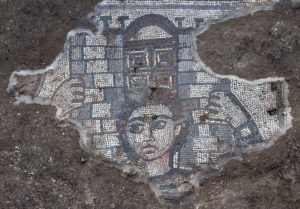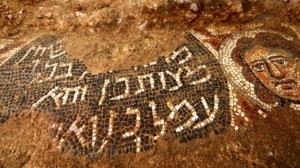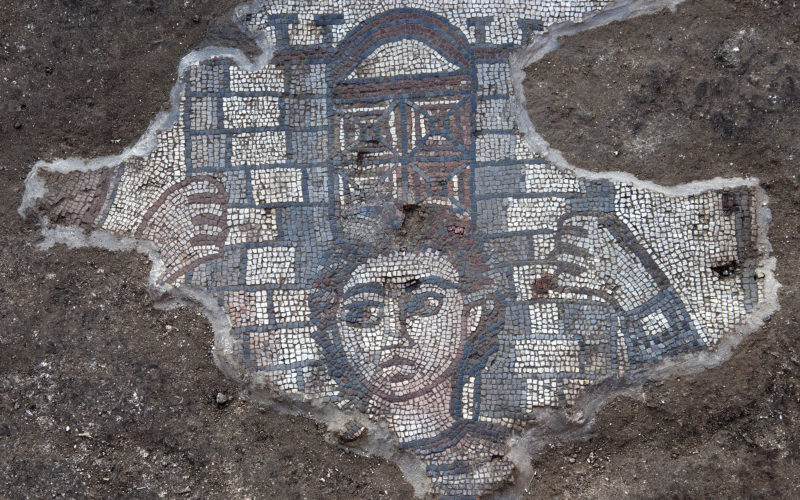Samson Found!
 Professor Jodi Magness and her team at Huqoq in Israel’s Galilee have discovered something significant. Fortunately for us, unlike Professor Yuval Goren who is digging at Tel Socoh with a bulldozer, Professor Magness is using a hoe and brush. What they are reporting is a monumental synagogue that they date as early as the 4th century. The ancient Jewish village is of particular interest to anyone investigating the birth of Christianity. It’s just a couple of miles west of Capernaum (where Jesus taught in the synagogue), and Migdal (Mary Magdalene’s hometown). During the 2012 excavations, a stunning mosaic floor was discovered in a building that Magness calls a “synagogue”. The mosaic includes a scene depicting Samson placing burning torches between the tails of foxes (as related in the Book of Judges 15:4).
Professor Jodi Magness and her team at Huqoq in Israel’s Galilee have discovered something significant. Fortunately for us, unlike Professor Yuval Goren who is digging at Tel Socoh with a bulldozer, Professor Magness is using a hoe and brush. What they are reporting is a monumental synagogue that they date as early as the 4th century. The ancient Jewish village is of particular interest to anyone investigating the birth of Christianity. It’s just a couple of miles west of Capernaum (where Jesus taught in the synagogue), and Migdal (Mary Magdalene’s hometown). During the 2012 excavations, a stunning mosaic floor was discovered in a building that Magness calls a “synagogue”. The mosaic includes a scene depicting Samson placing burning torches between the tails of foxes (as related in the Book of Judges 15:4).
During the present excavation season, the excavators have hit pay dirt again. They discovered another mosaic in the same area depicting Samson carrying the Gates of Gaza on his shoulders (Judges 16:3). In a recent article in Biblical Archaeology Review (Jan/Feb 2013) Magness compared her find to another “synagogue” in Wadi Hamam where a Samson image was discovered a few years ago. This is all very exciting but it creates a mystery. Why is Samson depicted in “synagogues”?
It’s clear from the archaeology that before the destruction of the Temple in Jerusalem in the year 70 CE, Jews did not depict any human faces – especially not in synagogues. So what is Samson doing here? The standard answer has it that although we thought that Jews didn’t depict human figures in synagogues, the archaeology has proven us wrong. “Synagogues” with mosaics depicting human figures, zodiacs and even Greek gods have been found in places such as Beit Alpha (6th century CE), Sepphoris (5th/6th century CE) and Tiberias (late 3rd or early 4th century CE). The common wisdom is that they are regular “synagogues”, and that they simply use pagan images e.g., the sun god Helios, as a matter of fashion. But Professor Ross Shepard Kraemer has called this into question. She has said that the images of Helios had “religious significance” for the people who put them there. But what possible religious significance? Did the Jews in the Galilee go pagan and nobody noticed? Rabbinic literature doesn’t have a single reference to these kinds of images in synagogues.
Faced with a contradiction between the Rabbinic texts and her archaeology, Professor Magness has concluded that the rabbis were “biased”. They simply did not report the truth. But there’s another possibility, namely; that the so called “synagogues” are not synagogues. So far, archaeologists like Magness have built a circular argument. They find human figures in buildings and instead of concluding that the buildings are not synagogues, they conclude that the synagogues had images in them that contradict Jewish law. But let’s take a different approach. If they are not synagogues, what are they? And what are the sun god Helios and the Biblical strongman Samson doing in these mosaics?
Just a few days ago, I was under the Vatican looking at the earliest Christian tomb found in Rome and guess what? On its ceiling is an image of – you guessed it – Helios!
![IMG-20130702-WA001[1]](http://www.simchajtv.com/wp-content/uploads/2013/07/IMG-20130702-WA0011-300x225.jpg)
In late Roman and Byzantine time, Jesus came to be depicted as Helios! But what about Samson? Surely he has nothing to do with Jesus. Well, not so fast. As Professor Magness knows very well, early Christian writers said that Samson is a “Christ-figure”. They pointed out that both Samson and Jesus’ births were prophesied by heavenly messengers. Augustine explicitly compared Samson with Jesus (Sermon 364:3). So here we have houses of worship that have images in them that are consistent with Christianity and inconsistent with Judaism and Magness concludes that she is looking at a synagogue. I’m sorry Professor Magness, if you’re looking at early Christian symbols – you’re looking at an early Christian church. I know there are Jewish ritual baths nearby but all that tells us is that the people worshipping in the churches were ethnic Jews. In other words, Magness may have found what scholars call a “Judeo Christian” house of worship – and she doesn’t realize it!
 In the Huqoq Judeo Christian church, Magness also found two human faces flanking a circular area with a Hebrew inscription that refers to rewards for those who perform good deeds. She concludes that they are female. Since women played an important part in the birth of Christianity, this is another indication that what she’s discovered is a Judeo Christian church. Most puzzling is another portion of the mosaic discovered in the synagogue’s east aisle. It preserves a scene that includes several male figures and an elephant. Below this is a walkway with the arches framing young men standing around a seated elderly man holding a scroll and below that there is a bull pierced by spears, with blood gushing from his wounds. I haven’t been able to see a picture of this part of the mosaic but Jewish it’s not. If we decipher it, maybe we’ll have a better understanding of that specific moment in time when Judaism and paganism met in the Galilee and gave birth to Christianity. One thing, I think, we can decipher is the latest find – Samson holding the Gates of Gaza on his shoulders. Is it just me or is the door above the head made to look like a cross?
In the Huqoq Judeo Christian church, Magness also found two human faces flanking a circular area with a Hebrew inscription that refers to rewards for those who perform good deeds. She concludes that they are female. Since women played an important part in the birth of Christianity, this is another indication that what she’s discovered is a Judeo Christian church. Most puzzling is another portion of the mosaic discovered in the synagogue’s east aisle. It preserves a scene that includes several male figures and an elephant. Below this is a walkway with the arches framing young men standing around a seated elderly man holding a scroll and below that there is a bull pierced by spears, with blood gushing from his wounds. I haven’t been able to see a picture of this part of the mosaic but Jewish it’s not. If we decipher it, maybe we’ll have a better understanding of that specific moment in time when Judaism and paganism met in the Galilee and gave birth to Christianity. One thing, I think, we can decipher is the latest find – Samson holding the Gates of Gaza on his shoulders. Is it just me or is the door above the head made to look like a cross?
In other words, the so called Samson figure may be one of the earliest depictions of Jesus ever made. Sorry Professor Magness, what you found is most probably a church, not a synagogue.
See: http://phys.org/news/2013-06-mosaics-synagogue-excavations-galilee.html and http://www.biblicalarchaeology.org/daily/biblical-artifacts/artifacts-and-the-bible/a-samson-mosaic-from-huqoq/

